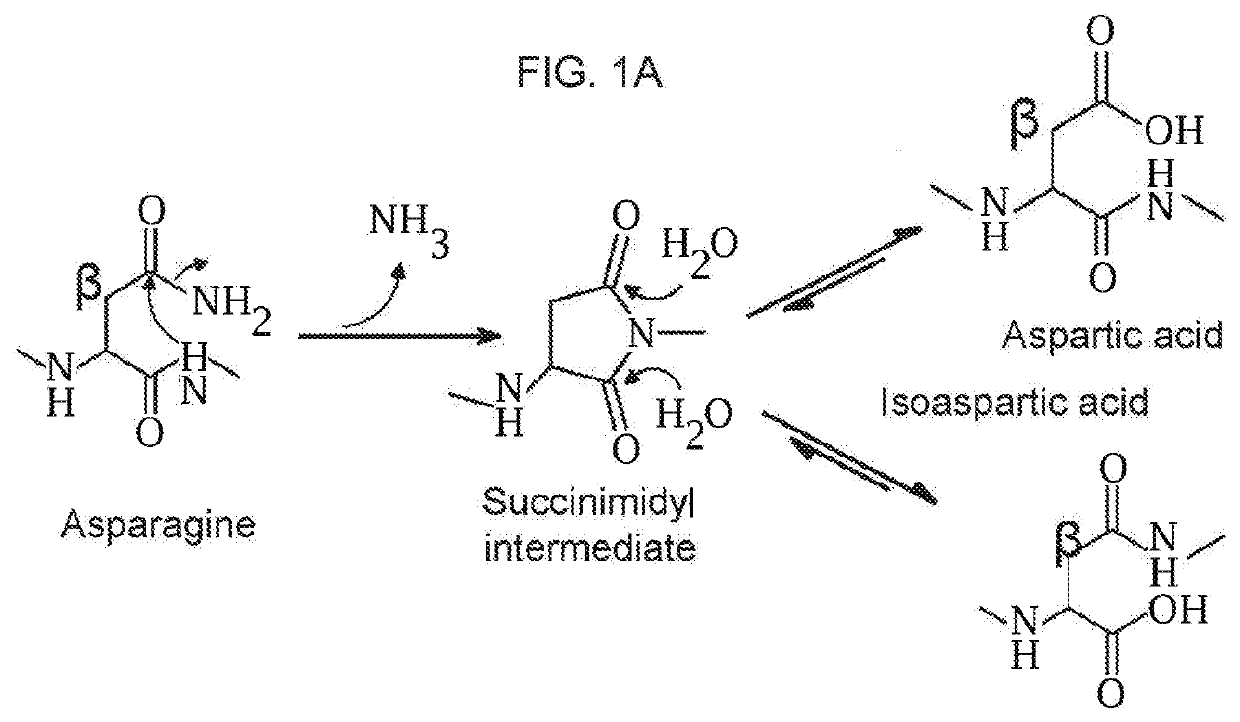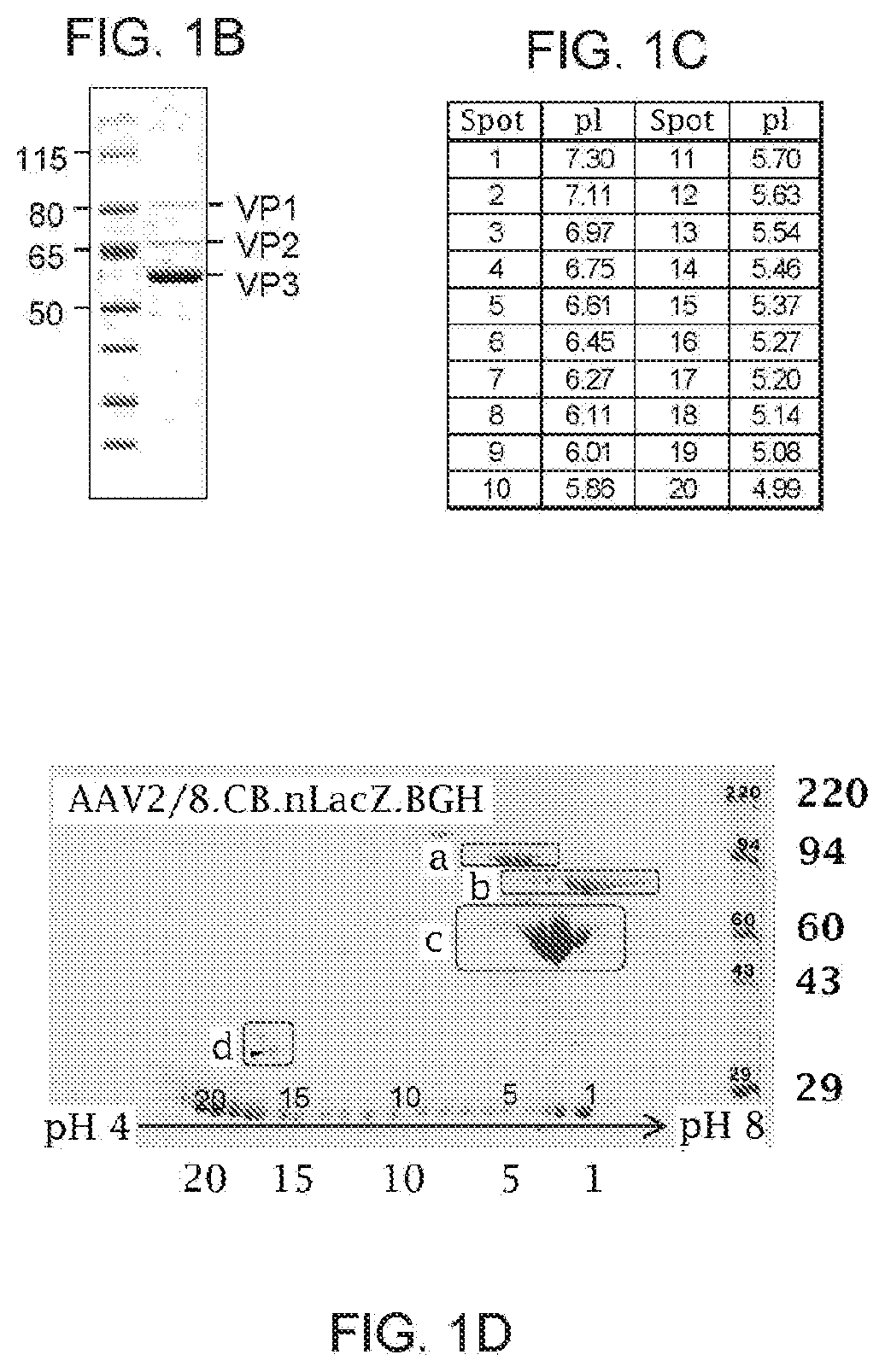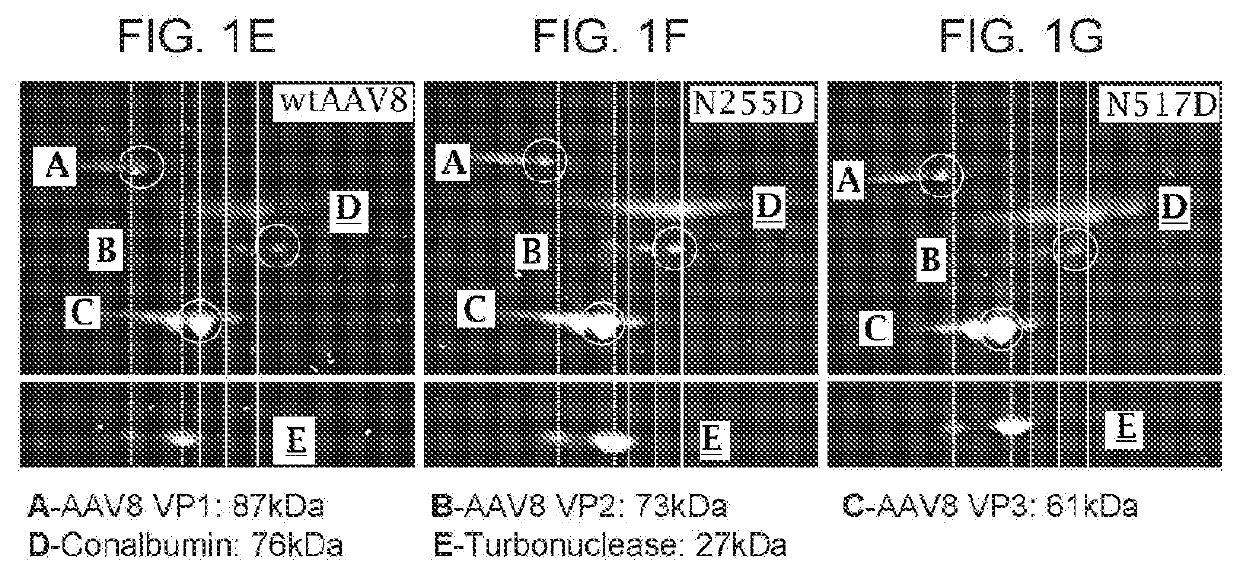Novel adeno-associated virus (AAV) vectors, aav vectors having reduced capsid deamidation and uses therefor
a technology of adenovirus and vector, which is applied in the field of new adenovirus vector, aav vector having reduced capsid deamidation, can solve the problems of complex development of drugs, and achieve the effects of reducing the deamidation of an aav, and increasing the titer, potency and/or transduction efficiency of an aav
- Summary
- Abstract
- Description
- Claims
- Application Information
AI Technical Summary
Benefits of technology
Problems solved by technology
Method used
Image
Examples
example 1
on of Amino Acids on the Surface of Adeno-Associated Virus Capsids
[0183]A. Materials and Methods
[0184]1. 1D and 2D Gel Electrophoresis For 1D SDS polyacrylamide gel electrophoresis (SDS-PAGE) analysis, we first denatured AAV vectors at 80° C. for 20 minutes in the presence of lithium dodecyl sulfate and reducing agent. Then, we ran them on a 4-12% Bis-Tris gel for 90 minutes at 200V and stained with Coomassie blue. For the data in FIG. 1A-FIG. 1D, Kendrick Laboratories, Inc. (Madison, Wis.) performed the 2D gel electrophoresis. For subsequent experiments, we performed 2D SDS-PAGE in-house. For this, we combined 3×1011 GCs of AAV vector with 500U turbonuclease marker (Accelagen, San Diego, Calif.) in 150μL phosphate buffered saline (PBS) with 35 mM NaCl and 1 mM MgCl2 and incubated at 37° C. for ten minutes. We next added nine volumes of absolute ethanol, vortexed the samples, and incubated them at −80° C. for at least two hours followed by incubation on ice for five minutes and cent...
example 2
on AAV8 Triple Mutant (Clade E)
[0243]An AAV8 triple mutant capsid was used to generate an rAAV vector. The predicted amino acid sequence for the VP1 protein of this capsid is provided in SEQ ID NO: 9 herein and a nucleic acid sequence encoding the capsid is provided in SEQ ID NO:8. See, also, PCT application PCT / US17 / 27392, published as WO 2017 / 180854.
[0244]AAV8Triple mutant vectors were assessed for deamidation as described in Example 1 for AAV8. Highly deamidated residues are seen at N57, N384, N498, N513, N539. Deamidation of 10% to 40% is observed at N94, N254, N255 N304, N409, N516.
AAV8 Triple mutantModificationSEQ ID NO: 9WL1938SWL1938SEnzymeTrypsinChymotrypsin% Coverage91.688.3 N57 + Deamidation93.191.9 N94 + Deamidation10.410.8~N254 + Deamidation 14.714.4~N255 + Deamidation 11.912.0N304 + Deamidation32.732.1N384 + Deamidation94.693.9N409 + Deamidation22.822.3N478 + Deamidation2.52.5~N498 + Deamidation 54.152.7N513 + Deamidation93.893.0N516 + Deamidation29.629.6N539 + Deamida...
example 3
eamidation Studies
[0245]Illustrative vectors were assessed for deamidation as described in Example 1 for AAV8 and AAV9. AAV1 falls within Clade A, AAV7 falls within Clade D, while AAV3B, AAV5, AAVrh32 / 33, and AAV4 are outside any of the clades A-F.
[0246]A. AAV1 Deamidation
[0247]AAV1 vectors were assessed for deamidation as described in Example 1 for AAV8 and AAV9. The results show that the vectors contain four amino acids which are highly deamidated (N57, N383, N512, and N718), based on the numbering of the primary sequence of the AAV1 VP1 reproduced in SEQ ID NO: 1.
[0248]B. AAV3B Deamidation
[0249]AAV3B vectors were assessed for deamidation as described in Example 1 for AAV8 and AAV9. High levels of deamidation are observed at four asparagine residue, N57, N382, N512, and N718, with reference to the numbering of AAV3B. These numbers are based on the AAV3B VP1 reproduced in SEQ ID NO: 2.
[0250]C. AAV5 Deamidation
[0251]AAV5 vectors were assessed for deamidation as described in Example...
PUM
| Property | Measurement | Unit |
|---|---|---|
| mass spectrometry | aaaaa | aaaaa |
| composition | aaaaa | aaaaa |
Abstract
Description
Claims
Application Information
 Login to View More
Login to View More - R&D
- Intellectual Property
- Life Sciences
- Materials
- Tech Scout
- Unparalleled Data Quality
- Higher Quality Content
- 60% Fewer Hallucinations
Browse by: Latest US Patents, China's latest patents, Technical Efficacy Thesaurus, Application Domain, Technology Topic, Popular Technical Reports.
© 2025 PatSnap. All rights reserved.Legal|Privacy policy|Modern Slavery Act Transparency Statement|Sitemap|About US| Contact US: help@patsnap.com



